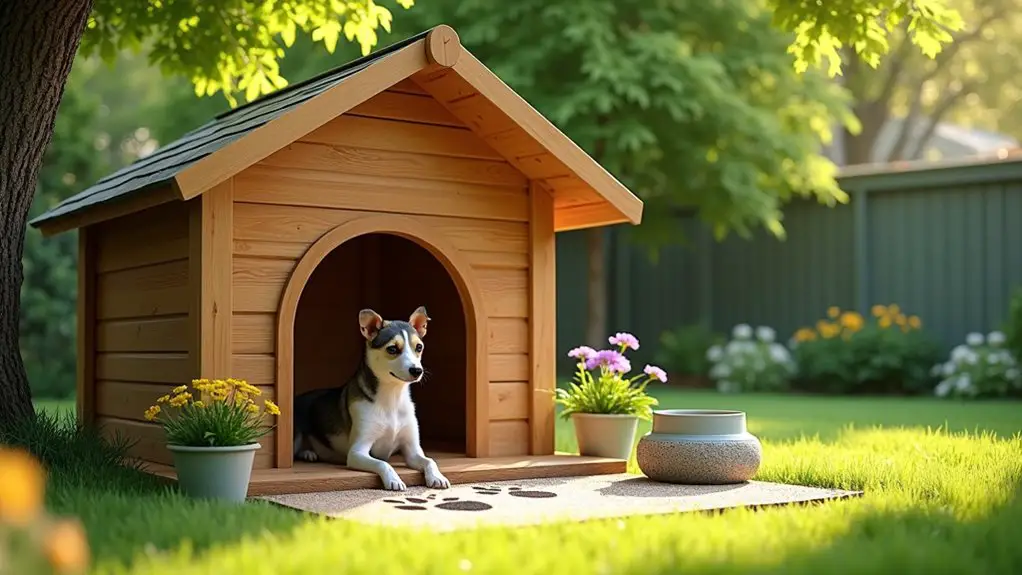Remember how Dorothy clicked her heels to get home? Well, your pup deserves their own cozy escape, too. Imagine building a dog house that matches their personality—how cool would that be? From whimsical castles to sleek modern designs, there’s a plan for every taste. So, why not give your furry friend a space that makes them wag their tail with glee? Let’s explore some innovative ideas that might just inspire your next weekend project.
Top 10 Unique Dog Houses
When it comes to unique dog houses, you might be surprised at how many creative options are out there—ten, to be exact, and trust me, they’re pretty pawsome.
Picture your pup lounging in a charming mini-castle or a chic modern abode; how cool would that be? Among these creative dog house plans, you’ve got everything from a cozy log cabin to a quirky airplane design.
Think about a treehouse for your furry friend, or a stylish A-frame that makes your backyard pop. Each option adds personality and flair, showcasing your pup’s uniqueness.
Plus, building one of these could give you some serious bragging rights at the dog park. After all, who doesn’t want a house cooler than theirs?
1. Eco-Friendly Dog House Designs

When it comes to creating a cozy retreat for your furry friend, eco-friendly dog house designs hit the mark on both functionality and style. Imagine a doghouse that not only keeps your pup comfy but also respects Mother Earth.
These designs combine durable materials with innovative features, making them a wonderful choice for the environmentally conscious pet owner. Picture a small haven where your dog can enjoy the fresh air without contributing to the decline of our planet. Sounds perfect, right?
Eco-friendly dog houses offer durable, innovative designs that create a serene retreat for your pup while caring for our planet.
Design/Styling Tips:
- Materials Matter: Choose sustainable materials like reclaimed wood, bamboo, or even recycled plastic. These options usually have a smaller carbon footprint and are often just as sturdy as traditional lumber.
- Ventilation is Key: Incorporate adjustable vents or windows for airflow. Your pup will appreciate having a breeze on warm days!
- Natural Insulation: Fill the walls with recycled insulation, straw, or even unused clothing for warmth during those chilly nights. Just don’t forget your dog has a taste for chewing, so make sure it’s safe.
- Green Roofs: If you’re feeling adventurous, why not add a living roof? Line it with soil and native plants, creating an adorable green space that also helps with insulation. Just imagine a little garden your dog can admire (or dig up—let’s be real). Additionally, consider using premium outdoor kennels for enhanced comfort and protection.
- Decor and Personal Touches: Paint the house with non-toxic, eco-friendly paint. Consider adding a solar light or using reclaimed patio stones for a charming path leading up to the house.
Optional Variation: If you’re looking to save a few bucks, consider building your eco-friendly doghouse using pallets. They’re often available for free or at a low cost, and you can get creative in how you assemble and decorate them.
On the flip side, if you want to level up for a luxury feel, install solar panels. A small solar panel can power a night light or fan, creating an extra comfy haven for your four-legged companion. Additionally, opting for a premium dog kennel outdoor can enhance your pet’s outdoor experience while maintaining a stylish look. Incorporating a premium outdoor dog kennel can also provide an extra layer of safety while your dog enjoys the outdoors.
Building an eco-friendly dog house isn’t just a project; it’s a way to show your love for both your dog and the planet.
And hey, as you and your pup lounge in the yard, soaking in the sunshine, you’ll share a sense of accomplishment—and perhaps a tasty snack or two for the doggie taste test (just don’t feed them chocolate; that’s a definite no-no).
2. Luxury Indoor Dog Houses
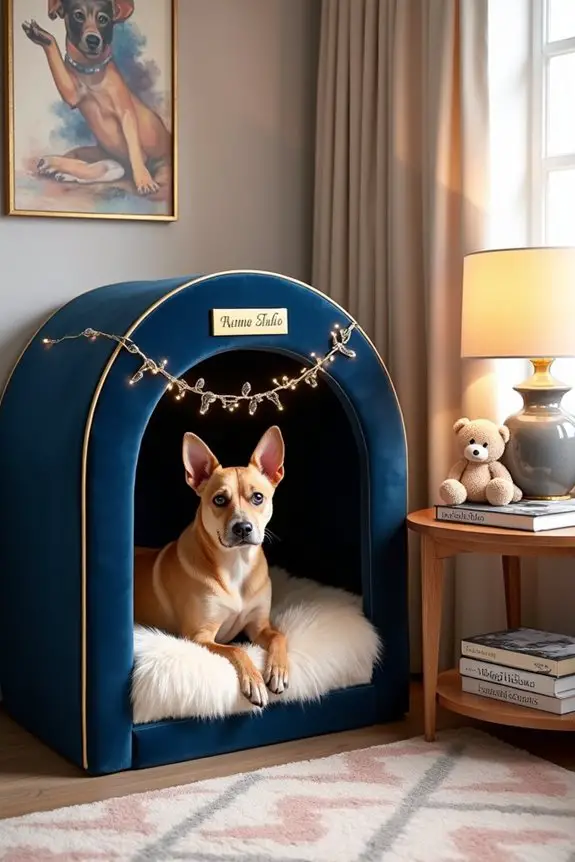
There’s nothing quite like a luxury indoor dog house to elevate your pup’s living quarters to the next level. Think of it as your dog’s own private suite, where they can lounge stylishly while you impress your friends with your pooch’s posh digs. Not only does it provide a cozy retreat for your furry friend, but it also adds a chic touch to your home décor. Additionally, incorporating a custom design that reflects your home’s aesthetic can make the dog house a true statement piece.
Plus, with a little creativity and some quality materials, you can create a space that feels as fabulous as a five-star hotel—because why shouldn’t your dog live like royalty? Remember, creating a cozy nook**** for your dog is just one way to ensure their happiness and comfort.
Design/Styling Tips:
- Choose Quality Materials: Opt for plush fabrics like velvet or leather for the interior. Think high-end dog beds cushioned with memory foam for ultimate comfort. Your pup deserves only the best, right?
- Create a Cozy Nook: Design an enclosed space that snuggles your dog with warmth. A corner of the living room or a small alcove works wonders. Add some curtains for a cozy hideaway feel; it’s like giving your dog their very own VIP lounge.
- Incorporate Personal Touches: Customize the space with your dog’s name in stylish lettering or use decor that matches your home’s interior theme. Maybe a chic print or pattern on the bedding can tie everything together. Just avoid color clashes—nobody wants a fashion faux-paw in their living room.
- Lighting and Accessories: Soft ambient lighting can create a warm, inviting atmosphere. Think fairy lights or a small lamp to illuminate the space. Consider adding some plush toys or even a few books about dog care—I mean, who wouldn’t want to see “Doggy Wisdom” on the shelf?
- Accessibility and Safety: Confirm your doghouse isn’t located in a high-traffic area, and that entrances are wide enough for your dog. Safety first, style second, right?
Optional Variation: To keep things budget-friendly, look into upcycling an old piece of furniture like a cabinet or bookshelf. With a little creativity (and perhaps a DIY guide for your inner crafter), you can transform it into an adorable doghouse without breaking the bank.
If you’re ready to splurge, think about incorporating a heated bed for those chilly nights, turning your dog’s nook into a toasty retreat they won’t want to leave.
Imagine your pup, snuggled up in their luxurious den, surrounded by all the comforts of home. You can picture it, right? You, sipping your coffee, peeking over the edge of your laptop, or steeling yourself to face the world with doggo vibes.
It sounds like a cozy dream come true—because a happy dog makes for a happy owner, and honestly, who else deserves a touch of elegance more than our beloved pups?
3. Customized Dog Bed Nooks
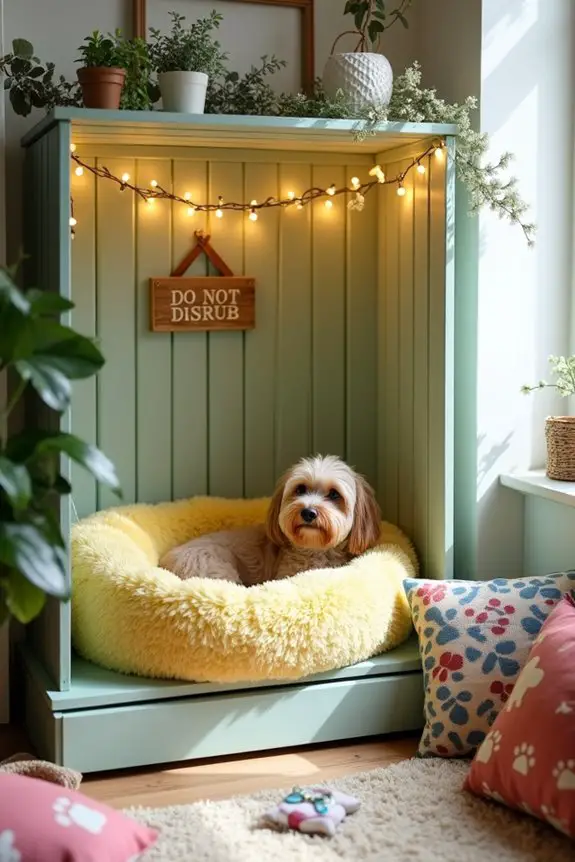
Creating a customized dog bed nook is the perfect way to blend function with style, giving your furry friend their own special spot while enhancing your home’s aesthetic. Just envision it: a cozy, puffy bed tucked away in a charming alcove, giving your pup a space that feels uniquely theirs. Not only is this nook a haven for comfort, but it also adds a custom vibe to your home, making it a delightful focus point that dog lovers and guests will admire.
Design/Styling Tips:
- Select the Right Spot: Look for a quiet corner or nook in your home. It could be beside a favorite spot like a window or even a corner of the living room where they can watch the world go by.
- Choose Your Materials Wisely: Go for soft, washable fabrics for the bed and surrounding decor. Consider using faux fur or a plush blanket paired with a sturdy dog bed as the base. Safety and comfort should go hand in hand.
- Add Fun Accents: Think about adding some cute themed décor. From colorful pet-themed pillows to a small ‘Do Not Disturb’ sign, playful touches can make the nook feel welcoming and special.
- Light It Up: If the nook feels a bit dark, consider stringing some battery-operated lights around the area. It gives a warm, cozy glow that makes it feel inviting, especially during the evenings.
- Create a Standing Base: Elevate the bed nook with a platform or wooden frame, giving it a more completed look. This way, not only does it add style, but it’s also easier for your dog to hop in and out.
Optional Variation: Want a budget-friendly twist? Scour thrift stores for an old wooden crate. With a bit of sanding and some paint, it can serve as a stylish dog bed nook that’s both charming and cozy. If you’re feeling fancy, add a few plush cushions, and voilà, you have an adorable and unique space for your pup without emptying your wallet.
Just imagine your pup curling up in their personalized nook after a long day of chasing squirrels or napping in sunny spots. There’s something incredibly heartwarming about that image, right?
You might even feel a twinge of longing as you look at their perfect little haven while you contemplate your own pillow fort plans. Look out, world. Your pup is about to live in style.
4. Space-Saving Vertical Dog House
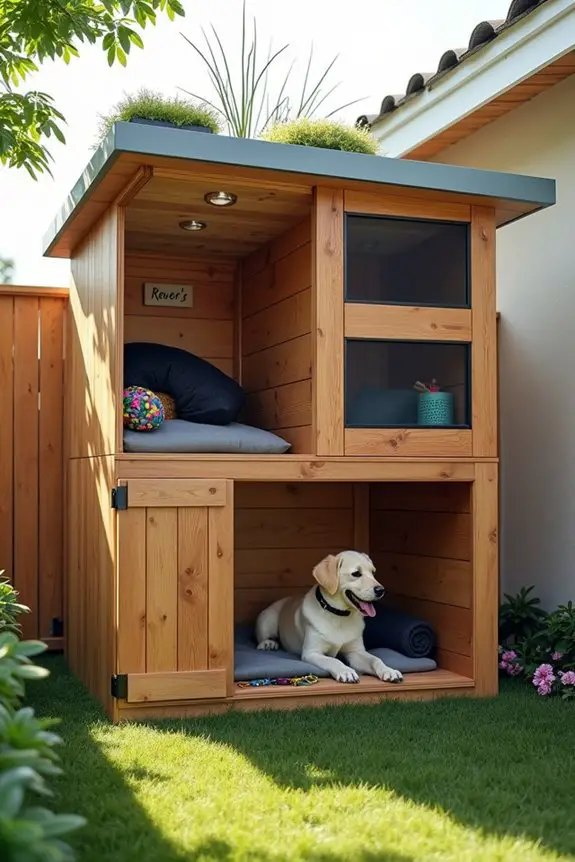
When it comes to dog houses, space-saving solutions are a game-changer, especially for those of us living in smaller spaces or with limited yard room. A vertical dog house not only offers your furry friend a cozy hideaway but also embraces a stylish, modern aesthetic that can enhance even the tiniest of backyards or balconies.
Just picture it: a charming structure that stands tall instead of wide, giving your pup a cool spot to call their own while keeping your outdoor area open and airy.
Imagine a delightful vertical dog house that provides your furry friend a cozy retreat while keeping your outdoor space spacious and inviting.
Design/Styling Tips:
- Build Upwards: Opt for a design that uses vertical space, perhaps a two or three-tiered structure. This gives your dog a cozy nook up high while leaving room below for storage, like toys or leashes.
- Select the Right Materials: Use durable weatherproof wood or composite materials to withstand the elements. Consider using natural stains or paints that match your home’s exterior for a cohesive look.
- Go for Windows: Add small, screened-in windows to keep airflow going and give your pup a view of the outside world. After all, who wouldn’t want to stare at the mailman from their own penthouse?
- Roof Options: Consider a sloping or flat roof that doubles as a small deck! It gives your dog a little outdoor space for sunbathing or even just observing broader happenings in the neighborhood.
- Accessorize with Style: Think about incorporating a little decorative flair, like hanging plants or a cute nameplate, to make it feel special—how about something like “Rover’s Retreat” or “Daisy’s Den”?
Optional Variation: If you’re looking to save some bucks on this project, check local listings for pre-owned wooden shelves or crates. With some wood glue and a splash of paint, you can create a one-of-a-kind vertical dog house that’s light on your wallet but heavy on charm.
Just think about that tail wagging with excitement as they explore the nooks and crannies of their new high-rise home.
And hey, you might even feel a little envious. Who wouldn’t want a whimsical space to call their own? Now your pup can enjoy stylish living, while you get the added bonus of decluttering your outdoor area. Win-win, wouldn’t you say?
5. Repurposed Pallet Dog Houses

If you’re looking for a unique way to give your furry friend a cozy spot while also being kind to the environment, a repurposed pallet dog house is just the ticket. Not only do these charming little homes help reduce waste by reusing materials, but they add a rustic vibe to your yard that’s simultaneously trendy and heartwarming.
Picture your pup snuggled up in a wonderfully weathered wooden abode that tells a story of transformation and creativity; it’s fundamentally the DIY equivalent of a warm hug.
Design/Styling Tips:
- Choose Quality Pallets: Start by sourcing pallets that are sturdy and free from chemical treatments. Look for “HT” stamped pallets—this means they were heat-treated and not chemically treated, keeping your dog safe.
- Basic Structure: Disassemble a few pallets to form the walls and the roof. You’ll want a solid base—the floor can be made from a single pallet laid horizontally, ensuring it’s elevated with some blocks to keep it off the ground.
- Ventilation is Key: For airflow and comfort, incorporate vents or small gaps between some of the slats. You might even consider using chicken wire for a more finished look while letting fresh air circulate.
- Roofing Options: A simple sloped or gabled roof works wonders for rain runoff. Cover it with weatherproof roofing material or even shingles if you want that extra flair.
- Personal Touches: Decorate with a coat of non-toxic paint or wood stain.
6. Themed Dog House Ideas
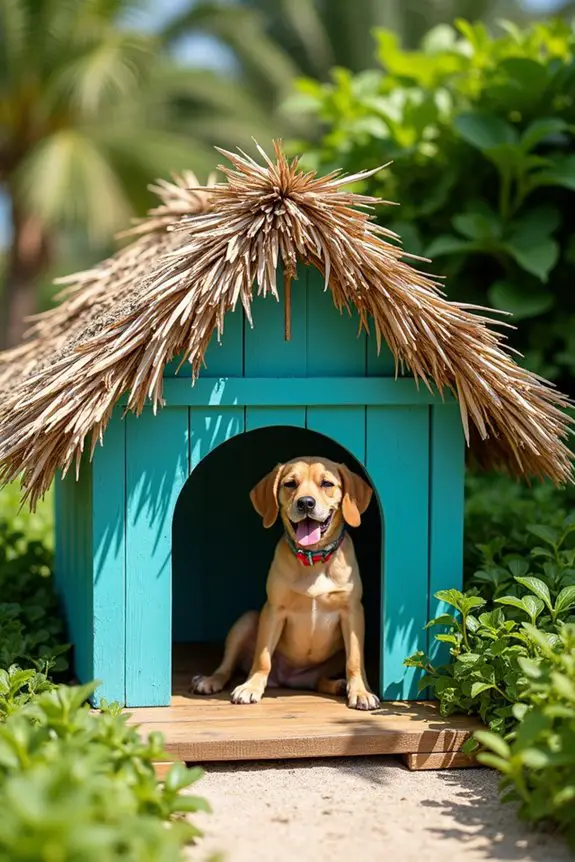
If you’re looking to take your pup’s living situation from basic to downright fabulous, themed dog houses are the way to go.
These creative little abodes not only offer a fun, stylish spot for your furry friend but also add a dash of personality to your yard. Imagine your dog lounging in a beach hut or a miniature castle—it creates a whimsical vibe that certainly sparks joy for both you and your pet.
Transform your yard with a themed dog house that sparks joy for both you and your furry friend.
Plus, it’s a fun bonding project that lets you express your inner designer.
Design/Styling Tips:
- Choose Your Theme: Think about what excites you and what might amuse your pooch. Popular ideas include beach bungalows, cozy log cabins, modern minimalistic homes, or even a classic fairy tale castle.
- Materials: Use wood, pallets, or even repurposed items to give your dog house a unique character. For a beach hut, light wood and bright colors work beautifully, while a log cabin could benefit from rough-hewn logs and a darker stain.
- Roofing and Structure: Depending on your theme, you might opt for a thatched roof effect for the beach hut or a peaked roof resembling a castle. Remember, sturdy is essential, but it doesn’t have to be boring.
- Add Fun Details: Paint your dog’s name on the house, add a welcome mat, or place a little picket fence around it. For a beach theme, maybe toss in a beach ball or a faux palm tree—just make sure nothing is chewable or hazardous.
- Accessorize: Consider using themed blankets or pillows inside. Not only do they add comfort, but they also pull the whole look together, making it a stylish hangout spot.
Optional Variation:
On a budget? Look for thrift store finds or clearance items that can fit your theme—old furniture, doors, and decor can be repurposed to create a one-of-a-kind dog house without breaking the bank.
If you’re ready to splurge a bit, try adding custom artwork or even a small dog-friendly garden area around the house to enhance that luxurious vibe.
7. Customizable Dog House Kits
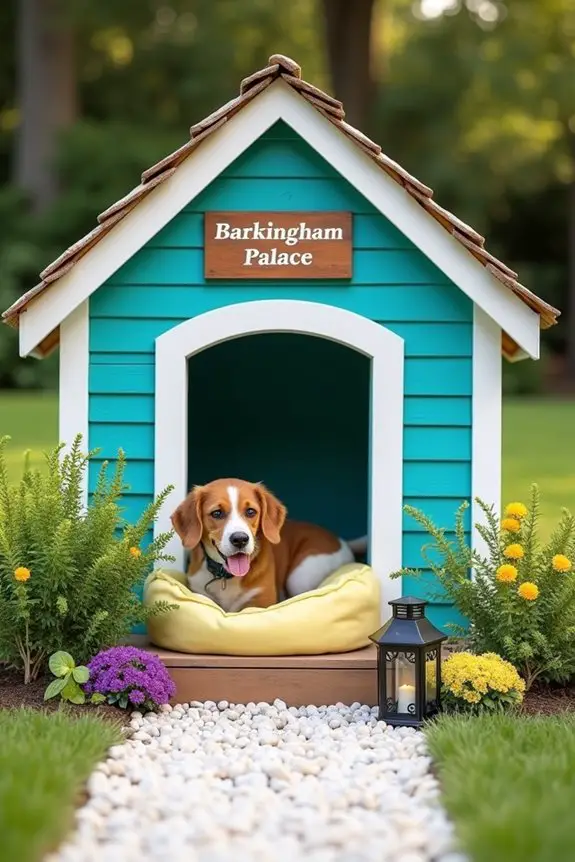
If you’ve ever thought about giving your dog a special retreat, a customizable dog house kit might be just what you need. These kits provide a fun and convenient way to create a space that’s tailored specifically for your furry companion.
Not only do they allow your dog to have their own personal hangout, but they also give you the chance to flex your creative muscles and make something unique. Imagine the delight on your pup’s face when they’ve a comfortable, stylish dome of their own, designed just for them.
It’s like a little castle where they rule the roost—royalty deserved, right?
Design/Styling Tips:
- Select the Right Kit: There are various kits available online or at your local pet store. Look for one that matches your dog’s size and your desired style. Some kits even offer pre-painted options, which can save a step or two.
- Customize with Paint or Stain: Don’t settle for the plain wood finish! Paint it your dog’s favorite color (whatever that may be)—perhaps a calming blue or a cheerful yellow. If you’re feeling fancy, you could even use a paint that resembles a beach setting or wood stain for a rustic vibe.
- Add Personalized Touches: You could attach a cute plaque with your dog’s name above the entrance—think “Barkingham Palace” or “Canine Hotel.” Little touches like this make all the difference.
- Incorporate Cozy Bedding: Inside, lay down soft blankets or doggy pillows to create a welcoming retreat. Go for materials that are easy to wash since we all know how messy pups can be.
- Decorate the Entrance: Create a little walkway leading to the dog house with pebbles or mulch. Maybe even put a small potted plant nearby to brighten the area—just be sure it’s pet-safe.
Optional Variation:
Feeling thrifty? Instead of buying a full kit, look for plans online and gather materials from a hardware store or reuse wood from old furniture you have lying around.
You could even organize a DIY assembly day with friends, making it a fun group project. On the flip side, if you want to splurge a little, consider adding extras like a small solar-powered light or a cute little fence around the dog house for that picture-perfect yard scene.
Your pup deserves a bit of luxury too, don’t you think?
8. Heated Outdoor Dog Houses
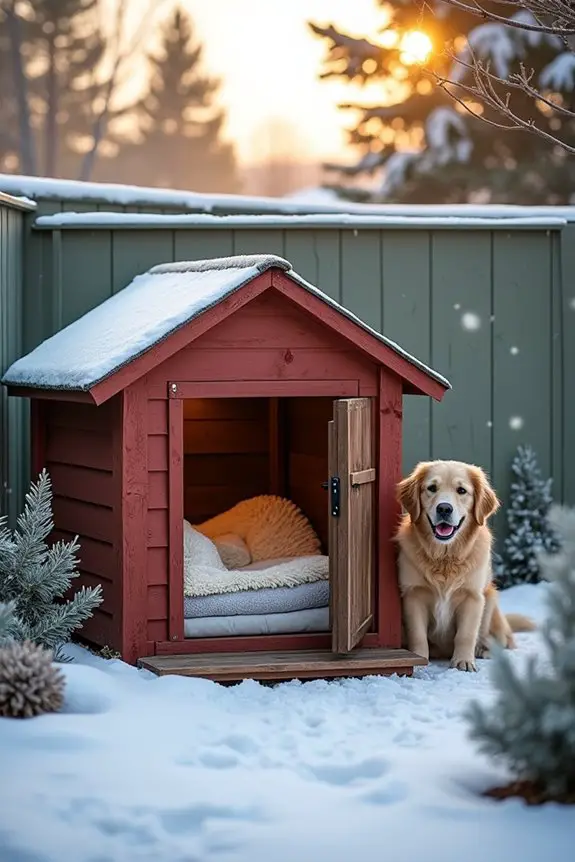
As the temperatures drop and chilly winds sweep in, our pups deserve a cozy refuge to escape the biting cold. Heated outdoor dog houses are a fantastic way to keep your furry friend warm and snug while also giving their outdoor space a touch of charm.
Not only do they provide warmth during the frigid months, but they also offer a stylish spot that reflects your love for your pet. Imagine your dog curled up, all warm and toasty, peeking out from their personal heated space—it’s a comforting picture, isn’t it?
Design/Styling Tips:
- Choose the Right Size: Pick a heated dog house that’s suitable for your dog’s breed and size. They should have enough room to stand, turn around, and stretch, but not so much space that the warmth escapes.
- Select Insulated Materials: Look for houses with insulated walls and floors. Materials like wood or composite are great choices, providing both durability and maximum heat retention.
- Install a Heated Pad: Purchase a pet-safe heated pad to place inside the dog house. Just like a cozy blanket, it gives your pup that extra layer of warmth while keeping things comfy.
- Elevate the House: Position the dog house a few inches off the ground. This assists with airflow and prevents the cold from seeping in from below. A simple wooden platform can do the trick.
- Add Soft Bedding: Line the inside with fluffy blankets or pet bedding, opting for materials that retain warmth while being easy to clean. A mix of low-maintenance and comfort is the goal here.
- Include a Windbreak: Consider placing a fence, shrubs, or even planting a couple of trees nearby that can act as a natural windbreak. Your pup will thank you later.
Optional Variation:
If you’re trying to save some bucks, you can create a DIY heated dog house by upcycling an old shed or a large wooden box. Just add insulation to the walls and a heated pad inside.
On the luxury side, think about installing a small energy-efficient heating system or a thermostat that automatically regulates the temperature. Why not give your pup a little thermostat for their personal spa?
9. Repurposed Vintage Suitcase Dog House
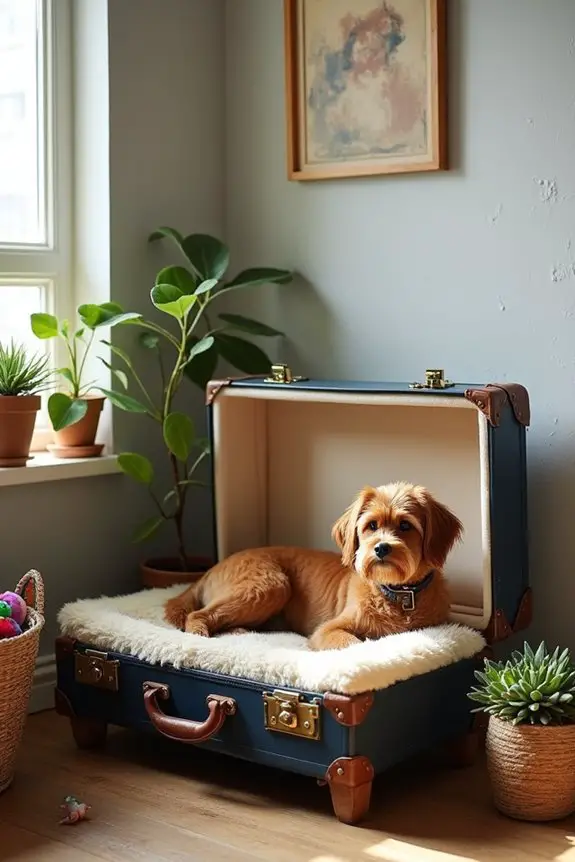
If you’re looking for a project that marries functionality with flair, then creating a dog house out of a repurposed vintage suitcase is a delightful choice. Not only does it provide a unique and chic retreat for your pup, but it also adds a charming vintage vibe to your decor.
Imagine your furry friend lounging stylishly inside a suitcase that once traveled the world—how cool is that? Plus, with just a little imagination and effort, you can transform an old, forgotten suitcase into a cozy retreat.
Design/Styling Tips:
- Choose the Right Size Suitcase: Look for a suitcase big enough for your dog to comfortably curl up in. A vintage hard-shell suitcase works best as it keeps its shape and provides sturdiness.
- Add a Cozy Interior: Line the inside with soft, warm fabric or a plush pet bed. Think fleece, flannel, or even a memory foam pad to pamper your pup. A suitcase that’s lined feels like a little cozy hug.
- Elevate it Off the Ground: Use wooden legs or bricks to raise the suitcase slightly. Not only does this keep it dry, but it gives your pup a space that’s personalized and protects from the elements.
- Ventilation Is Key: Drill tiny holes in the sides for airflow, ensuring your pup has a comfortable space even on warmer days. Just be mindful not to drill too close to the opening; we don’t want any escape artists here.
- Decorate it Up: If you’re feeling crafty, paint or decoupage the outside, using your dog’s favorite theme or your own personal style. Maybe a nod to their breed with some cute paw prints or a vintage map if your suitcase has traveled far and wide.
Optional Variation:
For a budget-friendly take, keep an eye out at thrift stores or yard sales. You’d be surprised what treasures folks are ready to part with.
On the luxury side of things, consider adding a small LED light inside for nighttime visibility or a warm glowing touch; it could even double as a nightlight. You don’t want your pup tripping over their own paws in the dark, after all.
Transforming a vintage suitcase into a dog house isn’t just a fun project; it’s a way to combine your love for your pet with an admiration for unique home decor.
10. Safety Considerations for Dog Houses
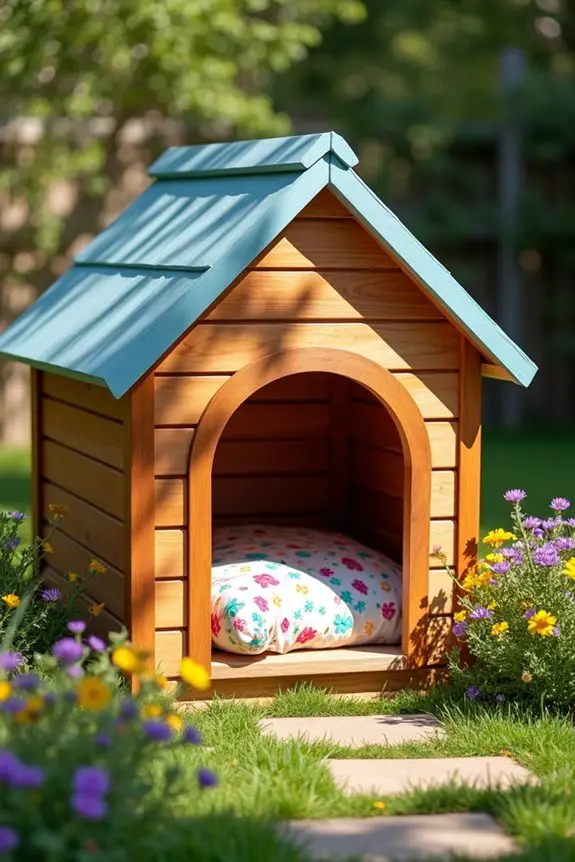
Creating a dog house is an exciting project, but it’s vital to keep safety at the forefront of your mind. After all, our furry friends rely on us for their comfort and protection.
Whether you’re fashioning a cozy retreat from scratch or repurposing an old item, certain safety measures can help guarantee that your pup’s new home is as safe as it’s stylish. Plus, knowing you’ve built a secure space for your furry companion can give you peace of mind, allowing both of you to truly enjoy the extra time spent outdoors.
Design/Styling Tips:
- Choose Non-Toxic Materials: When selecting wood or paint, make sure they’re pet-friendly. Avoid treated woods or toxic paints that could harm your dog.
- Shelter from the Elements: Position the dog house in a shaded area, or create a small overhang to shield your pup from rain and direct sunlight. A roof that tilts slightly can help with drainage too.
- Guarantee Proper Size: Make sure the doorway and interior space are comfortable, allowing your dog to enter easily and have enough room to curl up or stretch out. A dog house that’s too small can cause stress, while one that’s too large may make it impossible to retain heat during chilly nights.
- Secure the Structure: Use screws rather than nails for a more secure and durable build. Consider reinforcing corners and edges to prevent any wobbling or tipping.
- Avoid Sharp Edges: Sand down any rough patches or exposed nails and screws that could cut or snag your pet. A comfy space should feel like a safe haven, not an obstacle course.
Optional Variation:
For a budget-friendly twist, check your local freecycle or online community groups where folks often give away scraps of wood or old furniture. You can repurpose these materials rather than purchasing new supplies. This way, you’re saving money, helping the environment, and giving your dog a safe haven that’s also eco-friendly. How great is that?
Incorporating these safety tips into your dog house project not only elevates functionality but also provides a loving space for your dog that you can feel good about. After all, what’s better than knowing your pup is safe, snug, and absolutely loving their new home?
Essential Maintenance Advice
Keeping your dog house in top shape is just as important as building it right from the start. You might think it’s all about aesthetics, but regular maintenance can save you time and money down the line.
First, do a quick weekly check for loose shingles, cracks, and any pesky mold. Trust me, you’ll want to catch that before it turns into a major renovation project.
Cleaning the interior is essential too; dog fur seems to multiply, doesn’t it? A little shampoo and a good scrub will keep it cozy.
Don’t forget to treat the wood with weatherproof sealant. Think of it as giving your pal a stylish raincoat.
You’re not just building a house; you’re creating a fortress of love. Isn’t that worth it?

Hi, I’m Ali Tarek, the founder of Animalsman. I’ve always been passionate about pets, especially dogs and cats, and I created this website to share practical tips, easy recipes, and helpful care advice for fellow pet lovers. My goal is to make pet care simple, enjoyable, and accessible for everyone. When I’m not writing or curating content, you’ll usually find me spending time with my furry friends or learning new ways to keep them happy and healthy.

